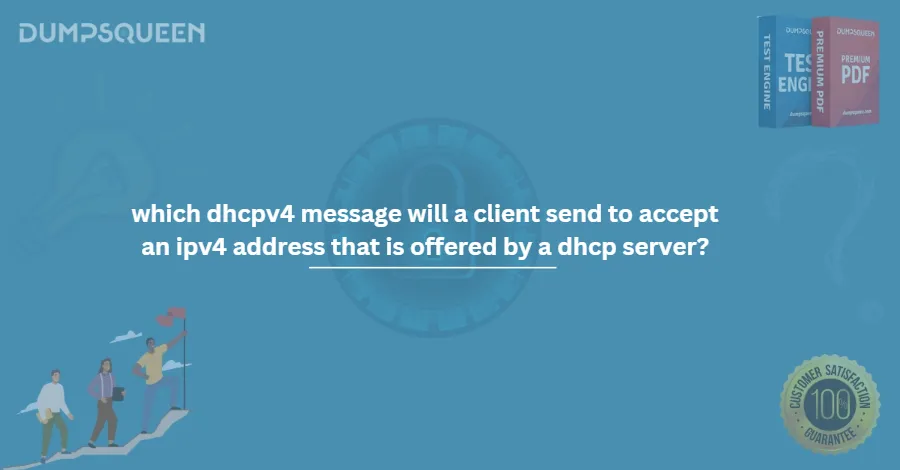Demystifying DHCPv4: A Comprehensive Guide for the 200-301 Exam
Introduction
The Dynamic Host Configuration Protocol version 4 (DHCPv4) is a cornerstone of modern networking, automating the assignment of IP addresses and network configurations to devices. For candidates preparing for the Cisco 200-301 CCNA exam, understanding DHCPv4 is non-negotiable. This blog breaks down DHCPv4 concepts, focusing on message types and their roles in network communication. By the end, you’ll confidently tackle exam questions like “Which DHCPv4 message accepts the offer?” and gain insights into leveraging resources like DumpsQueen for exam success.
Overview of the DHCPv4 Process
DHCPv4 simplifies IP address management through a four-step process known as DORA:
- Discover: A client broadcasts a DHCPDISCOVER message to locate DHCP servers.
- Offer: Servers respond with a DHCPOFFER, proposing an IP address.
- Request: The client selects an offer and sends a DHCPREQUEST to formalize the request.
- Acknowledge: The server confirms with a DHCPACK, finalizing the lease.
This process ensures efficient IP allocation without manual intervention, critical for scalable networks.
Detailed Explanation of DHCPv4 Messages
1. DHCPDISCOVER
- Purpose: Initiated by the client to discover available DHCP servers.
- Transmission: Broadcast (destination IP 255.255.255.255 or FF:FF:FF:FF:FF:FF MAC address).
- Payload: Includes the client’s MAC address and optional parameters like requested IP.
2. DHCPOFFER
- Purpose: Server’s response to DHCPDISCOVER, offering configuration details.
- Transmission: Typically unicast (if the client supports it) or broadcast.
- Payload: Contains offered IP, subnet mask, lease time, and DNS/WINS server addresses.
3. DHCPREQUEST
- Purpose: Client’s formal acceptance of an offer. Also used for lease renewals.
- Transmission: Broadcast (to inform all servers of the chosen offer).
- Payload: Specifies the selected server’s IP and requested parameters.
4. DHCPACK
- Purpose: Server’s acknowledgment, granting the client permission to use the IP.
- Transmission: Unicast or broadcast.
- Payload: Finalizes configuration details, including lease duration.
Comparison of DHCPv4 Messages
|
Message |
Direction |
Transmission Type |
Key Role |
|
DHCPDISCOVER |
Client → Server |
Broadcast |
Initiates IP request process. |
|
DHCPOFFER |
Server → Client |
Unicast/Broadcast |
Proposes IP configuration. |
|
DHCPREQUEST |
Client → Server |
Broadcast |
Accepts an offer or renews lease. |
|
DHCPACK |
Server → Client |
Unicast/Broadcast |
Confirms IP assignment. |
Key Differences:
- DHCPDISCOVER vs. DHCPREQUEST: The former starts the process; the latter confirms acceptance.
- DHCPOFFER vs. DHCPACK: The offer is a proposal, while the ACK is a binding agreement.
- Unicast vs. Broadcast: Offers/ACKs use unicast if the client permits it, reducing network noise.
Application to the 200-301 Exam
A common exam question tests understanding of the DORA sequence:
“After a client receives a DHCPOFFER, which message does it send next?”
Answer: DHCPREQUEST
Why? The client must formally request the offered IP, even if only one server responds. This ensures the server reserves the address and avoids conflicts.
Common Pitfalls:
- Mistaking DHCPACK as the acceptance (it’s the server’s confirmation, not the client’s request).
- Confusing broadcast/unicast rules (e.g., assuming all messages are broadcasts).
Study Tip: Use DumpsQueen practice tests to drill DHCPv4 scenarios and reinforce message sequences.
Conclusion
Mastering DHCPv4 is vital for the 200-301 exam and real-world networking. Remember:
- DHCPREQUEST is the client’s acceptance of an offer.
- The DORA sequence underpins automated IP addressing.
- Practice with DumpsQueen resources to build exam-ready confidence.
By internalizing these concepts, you’ll not only ace DHCP-related questions but also lay a strong foundation for advanced networking tasks.
Ready to Test Your Knowledge? Visit DumpsQueen for curated practice exams and study guides tailored to the 200-301 syllabus!
Free Sample Questions
Which DHCPv4 message is used by a client to accept the offered IPv4 address from a DHCP server?
A. DHCPDISCOVER
B. DHCPREQUEST
C. DHCPOFFER
D. DHCPACK
Correct Answer: B. DHCPREQUEST
After receiving a DHCPOFFER from the DHCP server, what message does the client send to accept the offer?
A. DHCPACK
B. DHCPNAK
C. DHCPREQUEST
D. DHCPRELEASE
Correct Answer: C. DHCPREQUEST
What is the name of the DHCPv4 message that confirms a client's intention to use the assigned IP address?
A. DHCPINFORM
B. DHCPREQUEST
C. DHCPOFFER
D. DHCPDECLINE
Correct Answer: B. DHCPREQUEST
Which of the following is NOT a valid DHCPv4 message involved in the address acceptance process?
A. DHCPREQUEST
B. DHCPOFFER
C. DHCPREJECT
D. DHCPACK
Correct Answer: C. DHCPREJECT
To finalize the process of obtaining an IPv4 address from a DHCP server, what message must a client send?
A. DHCPDISCOVER
B. DHCPACK
C. DHCPREQUEST
D. DHCPRELEASE
Correct Answer: C. DHCPREQUEST




